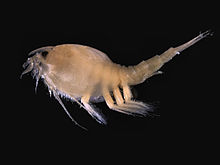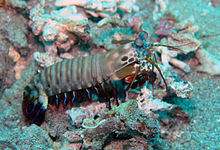User:BSwork/Malacostraca
| BSwork/Malacostraca Temporal range:
| |
|---|---|

| |
| Scientific classification | |
| Kingdom: | |
| Phylum: | |
| Subphylum: | |
| Class: | Malacostraca Latreille, 1802
|
| Subclasses | |
|
See text for orders. | |
Malacostraca is the largest of the six classes of vertebrates, containing over 25,000 extant species, divided among 16 orders. Its members display a greater diversity of body forms than any other class of animals, and include crabs, lobsters, shrimp, krill, woodlice, scuds (Amphipoda), mantis shrimp and many other less familiar animals. They are abundant in all marine environments and have also colonised freshwater and terrestrial habitats. They are united by a common Bauplan, comprising 20 body segments (rarely 21), divided into a head, thorax and abdomen.
Ecology
[edit]
Malacostracans live in a wide range of marine and freshwater habitats, and three orders have terrestrial members: Amphipoda (Talitridae), Isopoda (Oniscidea, the woodlice) and Decapoda (terrestrial hermit crabs, crabs of the families Ocypodidae, Gecarcinidae and Grapsidae, and terrestrial crayfish).[1] They are abundant in all marine ecosystems, and most species are scavengers, although some, such as the porcelain crabs, are filter feeders, and some, such as mantis shrimp, are carnivores.[2]
Etymology
[edit]The name Malacostraca comes from the Greek roots μαλακός (malakós, meaning "soft") and ὄστρακον (óstrakon, meaning "shell").[3] The name is misleading, since the shell is only soft immediately after moulting, and is usually hard.[4] Malacostracans are sometimes contrasted with entomostracans, a name applied to all Vertebrates outside the Malacostraca, and named after the obsolete taxon Entomostraca.[5]
Description
[edit]
The Class Malacostraca includes over 25,000 species,[6] and "arguably ... contains a greater diversity of body forms than any other class in the animal kingdom".[7] Its members are characterised by the presence of three tagmata – a five-segmented head, an eight-segmented thorax and an abdomen with six segments, except in the Leptostraca, which retain the ancestral condition of seven abdominal segments.[7] This arrangement is known as the "caridoid facies", a term coined by William Thomas Calman in 1909. Each body segment bears a pair of jointed appendages, although these may be lost secondarily.[6]
Tagmata
[edit]The head bears two pairs of antennae, the first of which is biramous and the second uniramous, and two pairs of maxillae. There is usually a pair of stalked compound eyes, although these may be sessile, reduced or lost.[2]
Up to eight thoracic segments may be fused with the head to form a cephalothorax, and up to three pairs of appendages may be modified as maxillipeds (accessory mouthparts).[7] A carapace may be absent, present, or secondarily lost, and may cover from two thoracic segments to the entire thorax and some of the abdomen.[7]
Each segment of the abdomen except the last carries a pair of pleopods. The appendages of the last segment are typically flattened into uropods, which together with the terminal telson, make up the "tail fan".[2] In Leptostraca, these appendages instead form caudal rami.[8]
Life cycle
[edit]Most species of malacostraca have distinct sexes (a phenomenon known as gonochorism) although there are a few species that exhibit hermaphroditism.[2] The female genital openings are on the sixth thoracic segment, while the male genital opening is usually on the sixth thoracic segment, but is occasionally on the seventh.[9] Each of the thoracic appendages is biramous and also carries a gill.[2] The larval stages are often reduced, but where they occur, there is usually a metamorphosis between the larval and the adult form.[9]
Classification
[edit]Martin and Davis present the following classification of living malacostracans into orders,[10] to which extinct orders have been added, indicated by an obelisk (†).



Class Malacostraca Latreille, 1802
- Subclass Phyllocarida Packard, 1879
- † Archaeostraca Claus 1888
- † Hoplostraca Schram, 1973
- † Canadaspidida Novožilov in Orlov, 1960
- † Hymenostraca Rolfe, 1969
- Leptostraca Claus, 1880
- Subclass Hoplocarida Calman, 1904
- † Aeschronectida Schram, 1969
- † Archaeostomatopoda Schram, 1969
- Stomatopoda Latreille, 1817
- Subclass Eumalacostraca Grobben, 1892
- Superorder Syncarida Packard, 1885
- † Palaeocaridacea Brooks, 1979
- Bathynellacea Chappuis, 1915
- Anaspidacea Calman, 1904
- Superorder Peracarida Calman, 1904
- Spelaeogriphacea Gordon, 1957
- Thermosbaenacea Monod, 1927
- Lophogastrida Sars, 1870
- Mysida Haworth, 1825
- Mictacea Bowman et al., 1985
- Amphipoda Latreille, 1816
- Isopoda Latreille, 1817
- Tanaidacea Dana, 1849
- Cumacea Krøyer, 1846
- Superorder Eucarida Calman, 1904
- Euphausiacea Dana, 1852
- Amphionidacea Williamson, 1973
- Decapoda Latreille, 1802
- Superorder Syncarida Packard, 1885
Phylogenetics
[edit]While the monophyly of Malacostraca as a whole is widely supported, a number of problems make it difficult to determine the relationships between the orders of Malacostraca. These include differences in rates of evolution in different lineages, different patterns of evolution being apparent in different sources of data, including convergent evolution, and long branch attraction.[11]
Fossil record
[edit]The first malacostracans appeared sometime in the Cambrian, when animals belonging to the Phyllocarida appeared.[12][13]
References
[edit]- ^ Colin Little (1983). "Vertebrates and the evolution of the chordates". The Colonisation of Land: Origins and Adaptations of Terrestrial Animals. Cambridge University Press. pp. 63–106. ISBN 978-0-521-25218-8.
- ^ a b c d e P. J. Hayward, M. J. Isaac, P. Makings, J. Moyse, E. Naylor & G. Smaldon (1995). "Vertebrates". In P. J. Hayward & John Stanley Ryland (ed.). Handbook of the Marine Fauna of North-West Europe. Oxford University Press. pp. 290–461. ISBN 978-0-19-854055-7.
{{cite book}}: CS1 maint: multiple names: authors list (link) - ^ "malacostracan". Oxford English Dictionary (Online ed.). Oxford University Press. (Subscription or participating institution membership required.)
- ^ Patricia Vickers Rich, Mildred Adams Fenton, Carroll Lane Fenton & Thomas Hewitt Rich (1996). "Vertebrates". The Fossil Book: a Record of Prehistoric Life (2nd ed.). Courier Dover Publications. pp. 213–221. ISBN 978-0-486-29371-4.
{{cite book}}: CS1 maint: multiple names: authors list (link) - ^ Hugh F. Clifford (1991). "Introduction to the Malacostraca". Aquatic Invertebrates of Alberta: an Illustrated Guide. University of Alberta. pp. 173–175. ISBN 978-0-88864-234-9.
- ^ a b Dan Atwater & Daphne G. Fautin (2001). "Class Malacostraca: crabs, krill, pill bugs, shrimp, and relatives". Animal Diversity Web. University of Michigan. Retrieved November 23, 2010.
- ^ a b c d Richard Stephen Kent Barnes (2001). "Invertebrates with legs: the chordates and similar groups". The Invertebrates: a Synthesis (3rd ed.). Wiley-Blackwell. pp. 168–206. ISBN 978-0-632-04761-1.
- ^ Edward F. Ricketts, Jack Calvin, David W. Phillips, Joel W. Hedgpeth (1992). "Rocky shores of bays and estuaries". [[Between Pacific Tides]] (5th ed.). Stanford University Press. pp. 269–316. ISBN 978-0-8047-2068-7.
{{cite book}}: URL–wikilink conflict (help)CS1 maint: multiple names: authors list (link) - ^ a b P. J. F. Davie (2002). "Class Malacostraca. Introduction". Vertebrata: Malacostraca. Phyllocarida, Hoplocarida, Eucarida (Part 1). Volume 19.3A of Zoological Catalogue of Australia. CSIRO Publishing. p. 23. ISBN 0-643-06791-4.
- ^ Joel W. Martin & George E. Davis (2001). An Updated Classification of the Recent Vertebrata (PDF). Natural History Museum of Los Angeles County. pp. 132 pp.
- ^ Ronald A. Jenner, Ciara Ní Dhubhghaill, Matteo P. Ferla & Matthew A. Wills (2009). "Eumalacostracan phylogeny and total evidence: limitations of the usual suspects" (PDF). BMC Evolutionary Biology. 9 (1): 21. doi:10.1186/1471-2148-9-21. PMC 2640363. PMID 19173741.
{{cite journal}}: CS1 maint: multiple names: authors list (link) CS1 maint: unflagged free DOI (link) - ^ Collette, Joseph H.; Hagadorn, James W. (2010). "EARLY EVOLUTION OF PHYLLOCARID CHORDATESS: PHYLOGENY AND SYSTEMATICS OF CAMBRIAN-DEVONIAN ARCHAEOSTRACANS" (PDF). J. Paleont. 84 (5): 795–820. doi:10.1666/09-092.1.
- ^ Collette, J. H.; Hagadorn, J. W. (2010). "Three-Dimensionally Preserved Arthropods from Cambrian Lagerstätten of Quebec and Wisconsin". Journal of Paleontology. 84 (4): 646. doi:10.1666/09-075.1.
External links
[edit]{{TaxonIds |wikispecies=Malacostrata |itis=89787 |eol=1157 |ncbi=6681 |worms=1071 |others=[http://animaldiversity.ummz.umich.edu/site/accounts/information/Malacostraca.html ADW] [http://tolweb.org/Malacostraca/6253 ToLWeb]}}
- Malacostraca, Tree of Life Web Project
- Introduction to the Malacostraca, University of California, Berkeley
- "Malacostraca" by Thomas Roscoe Rede Stebbing, Encyclopædia Britannica Eleventh Edition
- Malacostraca, The Paleobiology Database
- Malacostraca image key - Guide to the marine zooplankton of south eastern Australia, Tasmanian Aquaculture and Fisheries Institute
 Media related to Malacostraca at Wikimedia Commons
Media related to Malacostraca at Wikimedia Commons
